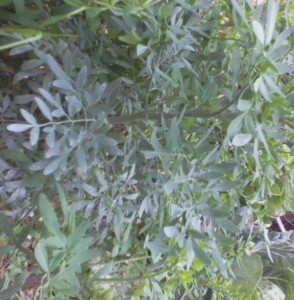The Herb of Grace
by Charlotte Tenney, MA Integrative Health
Common Rue (Ruta graveolens) is a plant rich in folklore, culinary and medicinal use and metaphorical meanings that are found in literature. It appears in remedies, recipes and Shakespeare’s plays and even in the Harry Potter books. It is also, like so many other Mediterranean imports, happy in our Southern California weather and soil. Rue lends contrast in the garden with its blue-gray leaves and its distinctive aroma. And while its symbolic meaning is often about regret and repentance (the herb that confers grace …), you will not rue the day that you plant Rue in your landscape.
I first became acquainted with Rue by watching my mother-in-law create her very effective home-remedy muscle liniment out of it. She had learned the recipe from a neighbor, who had shared the family tradition for dealing with sore, aching, over-worked limbs. As they both worked physically hard on farms, this was an important remedy. The recipe was a simple matter of filling a quart jar with a combination of fresh Rue leaves, Camphor gum and peppermint leaf, then pouring vodka over it all and letting it steep. The neighbor cautioned that it should be used on sore joints overnight, and then washed off in the morning, before going out into the sun. The ritual was more than superstition, since the oils in the Rue leaf can make skin overly photo-sensitive and result in a blistering rash when exposed to the sun. Many gardeners have learned this the hard way when pruning the plant with bare hands.

Common Rue (Ruta graveolens) is a plant rich in folklore, culinary and medicinal use and metaphorical meanings that are found in literature
This small, evergreen shrub was cultivated in Northern Africa, Egypt and ancient Rome to satisfy their taste for a bitter and aromatic flavor in their foods. It is an acquired taste, and a little goes a long way. It was frequently included, in small amounts, in fatty dishes as it has the effect of improving the digestion of rich foods. It is still used in egg dishes, soft cheeses, salads and more. In Italy, sometimes Grappa wine gets a sprig of Rue added to the bottle, making “grappa al ruta,” to infuse it with a distinctive bitter undertone; it was sipped after a meal to prevent flatulence and cramping.
Dogs, cats and witches are said to be repelled by the scent of Rue. You can take advantage of this by planting Rue around other plants that you wish to protect from neighborhood pets. Or use a twig of fresh Rue to fling holy water as a suspected sorcerer. In Medieval times it was hung around the house and barn to prevent magic spells or hexes from being cast. It is also an effective insect repellant, so perhaps the “evil spells” being prevented included bugs in the crops or stored grains. Rue-infused vinegar makes a good antiseptic cleaning solution and the lingering fragrance deters household pests such as fruit flies, moths and gnats. According to tradition, Rue stolen from your neighbor’s garden is the most effective.
Consuming the leaves of Rue was reputed to improve eyesight, especially for artists; Leonardo da Vinci was known to use it regularly. In current times, you can purchase Homeopathic preparations of Rue that echo this use and are recommended not only for acute vision, but also eye pain and headaches, sore neck muscles and persistent coughs.
As is the case with most intensely bitter herbs, consumption is not recommended for pregnant women, since the bitterness can trigger muscle contractions in the abdomen. And, as is true for all bitter-tasting herbs, using it in small amounts on a consistent basis will improve digestion, stimulate the immune system, and keep you “regular.”
Planting Rue in the garden offers the chance to foster a bit of folklore in your surroundings. It is a plant that can be pruned and shaped easily into an attractive hedge or mound, while it enhances the color and texture of your landscape. It suits our climate conditions and our need to conserve water. The leaf of the Rue was used as the model for the imagery in the Ace of Clubs in a deck of playing cards. It just might prove to be your “ace in the hole” for your garden.
Category: Life Style







